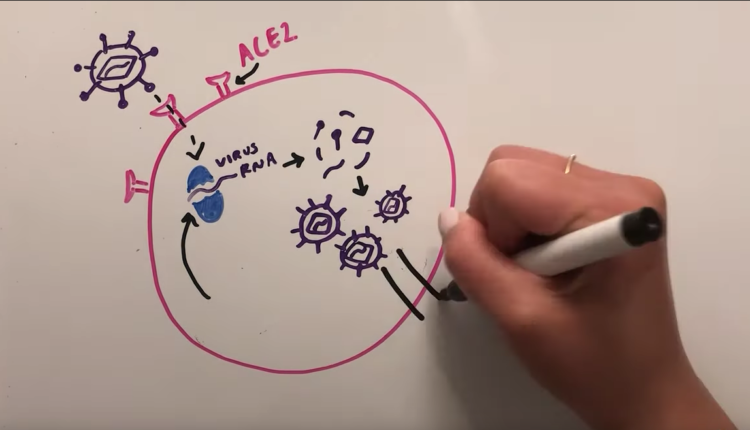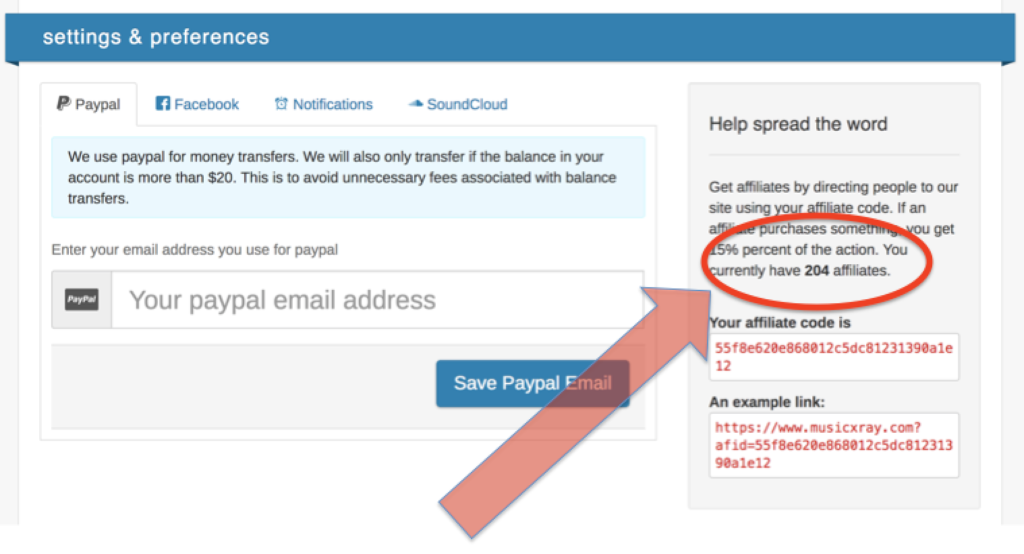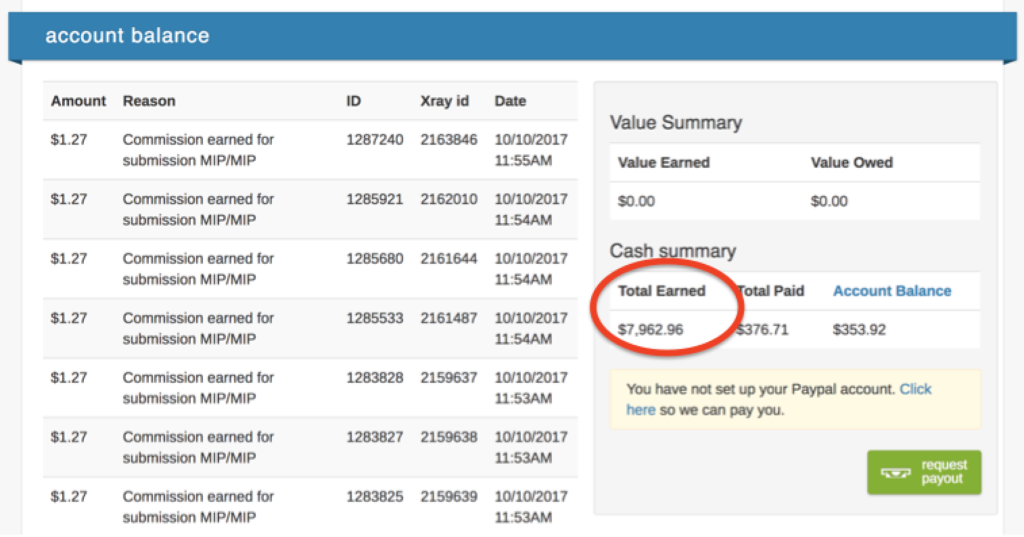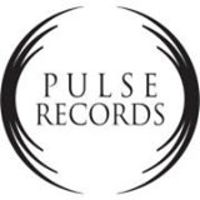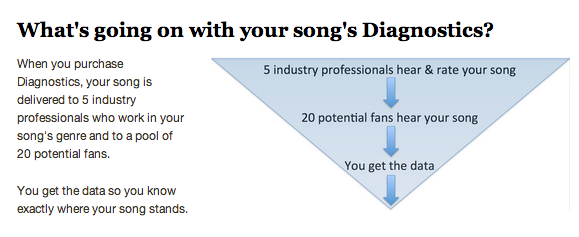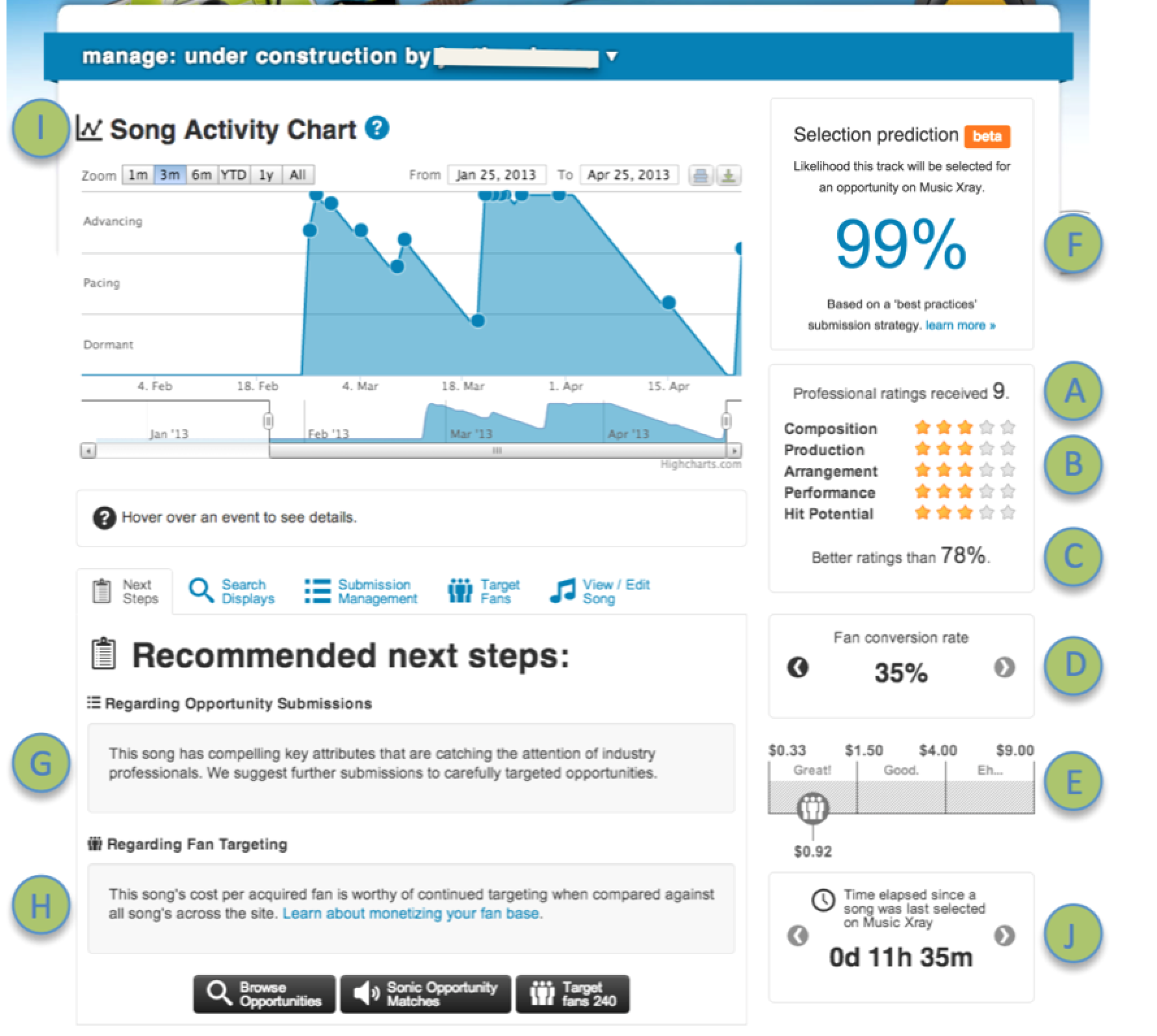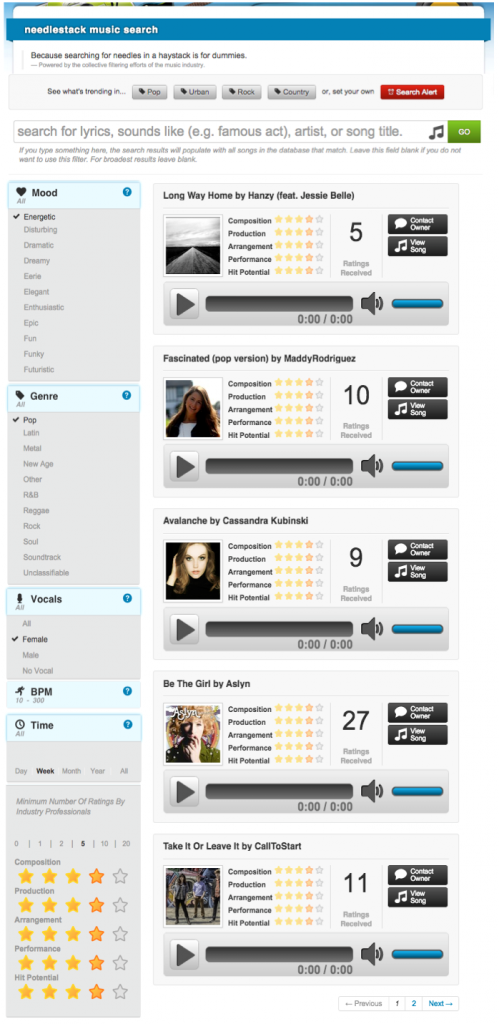In this video we tell you three things:
1. What most people think Music Xray is Vs. What Music Xray really is.
2. How to get the most of Music Xray without spending any money
3. How to get the most of Music Xray by spending the very least.
This video is about 25 minutes long but it is well worth your time. Those who watch it will have a competitive advantage over those who don’t.
Text version:
In this video I’m going to tell you three things.
1st – I’m going to tell you what most people think Music Xray is vs what Music Xray actually is.
2nd – I’m going to tell you how to get the most from the site without spending any money.
and 3rd – I’m going to tell you how to get the maximum value from the site by spending the very least.
It’s about 20 minutes long. But when you’re finished watching it you’ll be able to master the use of Music Xray.
So here we go…
What Most think Music Xray is vs What it actually is.
Most people assume Music Xray is an artist services company that helps musicians get their music to the attention of the talent scouts and decision makers in the industry – and the truth is that although we provide that service better and less expensively than any other company ever has, we do not think of ourselves PRIMARILY as an artist services company. Music Xray is PRIMARILY an industry filter.
We do not measure our success by how many artists we help get deals and exposure. We measure our success by how widely adopted Music Xray is by industry professionals and by how many of those professionals regard Music Xray as an indispensable tool for finding new songs and talent.
Many assume that our big business idea, and central to our strategy, is to hype the artists up, sell them the dream of making it big, and to collect as many submission fees as we possibly can.
But that’s not what we do at all. That’s an important distinction.
The job of an artist services company would be to sell as much to musicians as possible. But the job of a filter is to filter in the good stuff and filter out the stuff that isn’t quite ready or not appropriate for the available opportunities.
So in that effort we’ve invested a lot of resources in providing musicians with fast feedback and even meticulously calculated Selection Prediction scores that while not perfect, are pretty accurate. Often, that feedback serves as an early reality check. And the submission fees on the site aren’t there so we can get rich. They serve as the first stage of a multi-stage filter which puts the musicians in the position of filtering themselves first. Those who get great feedback and are gaining traction are encouraged to continue on. Those who get a reality check often reconsider whether they should keep spending resources on that song.
So if our big business idea isn’t to just collect submissions fees, what is our business? I’ll get to that.
But the immediate effect of submissions fees for the industry is that the music that is less likely to succeed makes way for the music that more professionals are going to want to hear. That keeps the industry engaged and respecting Music Xray as a source of more consistently high potential music. It turn, that’s better for the deserving artists whose music needs to break through the noise. That said, we know the filter isn’t perfect so our system doesn’t ban any musicians. If someone is supremely confident in their song or talent despite less that positive initial feedback, they can keep submitting – but since it costs a little bit of money for each submission, if the feedback doesn’t improve they will more than likely eventually accept it’s not going to happen for that song and stop pushing it. So just to be clear, we create the right incentives but we don’t shut anyone out.
I’m going to come back to this topic later in the video when I talk about how to get the very most for the least amount spent, but first I want to tell you how you can get value from Music Xray without spending any money at all.
How to get the most of Music Xray without spending money
There are a number of free features on Music Xray that many musicians use to advance their careers, and we’re all in favor of that. As I said, we’re not trying to extract every penny we can from musicians – our primary service is to the industry – so if we can be helpful to musicians without a cost to you and without detriment to us, then that’s a win for everyone.
Free feature number 1: Song to opportunity matching.
You can open an account for free on Music Xray and you can upload as much of your music as you want for zero cost. Each song you upload gets analyzed by our music analysis software and it gets compared to reference tracks that many industry professionals upload. So for each song you upload, you get a notification immediately telling you which industry professionals on the site have uploaded songs as references that sound and feel like yours. It’s not always a perfect match but it’s pretty good, and sometimes professionals upload reference tracks that don’t sound anything like what they’ve described in their brief when you go look at their listing so it can be confusing sometimes, but this gives you a good idea whether there are professionals on the site looking for what you’ve got.
Ideally, you would make your submission to these professionals through Music Xray but hey, this is the digital world and you’re going to Google the professionals, look them up on LinkedIn, Twitter, Facebook, & Instagram. So go for it unless they specifically say they don’t want to be contacted via other channels in which case you might tick them off. But even if they say that, you might get lucky. Some have. But those channels are pretty clogged and don’t have a filter so it’s harder to get their attention. If you don’t, you can always come back here.
You find the initial opportunity matches in that first notification but we re-run the matches every couple weeks, so you can always come back and check your notifications in the future for your opportunity Digest or you can always click the Sonic Opportunity Match button next to each song on your track dashboard to see what the most recent matches are.
Keep in mind that not all professionals on the site have uploaded reference tracks, so another way of getting free value from Music Xray is to just browse the opportunity listings. You can filter them by genre, amount the opportunities pay to chosen artists, type of opportunity, and more. There are usually more than 2000 available opportunities at any one time.
The next free feature is Fan Matching. There are nearly a million music fans with accounts on Music Xray and we track their listening habits via their Facebook accounts, which in turn are often linked to the Spotify accounts, plus they list their favorite major acts for us.
When you enter the metadata for your song, we ask you to list three major acts that influenced that particular song. When you enter the names of the acts, try thinking of the acts whose fans you think would love your song. Don’t be afraid to choose an obscure act. If it’s in our database our software will be able to know which other acts those fans like too, so actually, the more specific you are, the better.
Then, go back to the Tracks dashboard and you will see the number of potential fans in our database who might be your fans if only they heard your music. Since the fans on Music Xray are pretty reflective of the market in general, the information you can get for free is simply knowing which of your songs is likely to have the largest potential audience – and that can be valuable data as you decide how to promote your song through other channels. I’ll come back to how you can target the specific potential fans in our database a little later in this video.
The next free service on Music Xray I want to tell you about is the free song page and the free portfolios.
When you upload your song, it’s always good to enter the song’s metadata – as much as you can including the lyrics, an artist bio, license information, a YouTube video link if you have one, an image, and more. You will see that each song has a permalink. Click that and it takes you to your song’s own page. You can use that URL to send your song to anyone – including the previously mentioned industry professionals if you can reach them through other channels.
Additionally, you can create portfolios of songs – as many portfolios as you want – each containing a different number or combination of songs. Then you can send the link to the portfolio to anyone and they can play the songs right from that link and visit each individual song page if they want. That’s all free. Use the heck out of it!!
The last free feature may be the best one because it can actually get your song in front of industry professionals right on the site. It goes back to the metadata. Enter as much of it as you can. Here’s why.
One of our killer features for industry professionals is called Needlestack Music Search. It’s primary purpose is to show industry professionals the songs and acts that are being heard and rated highly by many other professionals. But often, music supervisors and others are looking for songs that are pretty obscure and may not have been heard by many professionals or maybe not by ANY professionals. So how could they find your song even if it’s never been submitted to a single professional on the site?
– They can upload a reference track right in that moment. If it sounds like yours and there are few other songs in the database that match and that have been heard by other professionals, or if the songs in the database that sound similar have been heard and rated poorly, your song will come up among the top matches.
– A professional might be looking for a song that was influenced by one of the acts that you entered in your metadata. Again, if there are few others or those others were poorly rated, your song could come up on top of the search.
– They could be looking for any combination of things but also enter more specific criteria like a beats-per-minute range, or a male or female vocal – or no vocal at all…..
Priority in the search engine is usually given to songs that match the professional’s search criteria and that have also been heard by other professionals and rated highly, but if the search is narrow enough and it matches your song, the professionals can hear it and have the option to contact you.
And that’s another thing. I know our site tends to send out too many emails. We’re taking steps to reduce that and we’re also going to implement a way for us to send you a text message to your phone specifically for when professionals are trying to contact you, but even if you grow numb to our emails, be sure you pay attention if you ever get one from us that has the word “selected” or “new message” in the subject line. These may be among the most important to your career.
Next, I want to stress to you that if your song is of the kind that has a hook – or a most compelling part, use the hook brackets to mark it. There are a lot of reasons for this.
1st – professionals are well, professionals and they want to get right to what they are looking for. Not all of them want to go straight to the hook, and those who don’t will just start your song from the beginning and play it through. But many may just pass over your song if there are other songs where they don’t have to wait for the gold. Give them the option to start at the hook. By not giving them the option don’t think you’re going to necessarily get a full listen of the song. Often, if you don’t grab their attention in the first few seconds you have it, you won’t get the next few seconds. Bracketing your hook is a way to make sure you hook their attention.
2nd – some professionals are looking for great hook writers or even great hooks they can license from you. Give them that option. Don’t worry, if you don’t want to sell the hook you can always say no. But don’t let an offer go by that your would otherwise have gotten – even if the only value is to create a new contact or start a new relationship with a professional in the industry.
There are many musicians who have used Music Xray to build relationships and actually never got an offer on the site, but have gone on to write for major artists due to relationships they established here.
OK. Now I’m going talk about how you can spend the least on the site and get the most value.
1st – Get Diagnostics for a few of your best songs – without submitting them to any opportunities yet.
Diagnostics is a required purchase for any song you may eventually submit to an opportunity. It costs $10 and you CAN buy it simultaneously with a submission but the only time I’d recommend that is if the opportunity you want to submit to has a tight window and is going to close soon. Otherwise, it’s best to wait for your Diagnostics results.
We didn’t create Diagnostics to get an extra $10 out of you. We created it so that you can get some fast, inexpensive, real feedback – and there’s another purpose for it that I’ll come back to a little later. But for you, the purpose is to find out how competitive your song is going to be for the opportunities currently on the site.
When a song goes through Diagnostics, it gets sent to 5 industry professionals who work in your song’s genre. They listen and they rate your song on 5 criteria – composition, production, arrangement, performance, and hit potential. Hit potential doesn’t necessarily mean “hit song” – it means commercial success potential for the type of song it is. A jazz song played on the accordion could, in theory, have high hit potential when compared to other jazz songs played on the accordion vying for opportunities looking for that kind of music. I just want to be clear about what that criteria means.
In Diagnostics, the song is also distributed out to 20 potential fans – selected randomly from among those who are fans of the acts you entered in your metadata. They each give the song a thumbs up or a thumbs down. And by the way, if they give it a thumbs up you get their email address and often a link to their Facebook profile so you can see who your fans are. You’re acquiring the fans, so to speak.
Once we have compiled the data, we show you some really cool things.
– The average ratings you got from the 5 professionals.
– The number and percent of fans who heard the song and gave it a thumbs up. This is your fan conversion rate and you can compare several of your songs to see which ones convert the highest percentage of fans. If you’re debating which song is your single, this could give you strong clues. We also show you what the cost of acquiring a fan is on Music Xray. If you decide you’d like to acquire more fans, we will send each potential fan your song for 33 cents each. Based on the percentage of those who hear it vs those who give it a thumbs up, we can calculate the approximate cost of acquiring each fan. In the future we plan to add the ability to geo-target your fans and to target by age and gender too. And you can always see the number of potential fans that exist in our database as calculated by the acts you entered in your metadata. So once you have this information from Diagnostics you can decide if you want to target more fans or not – and if it’s worth it to you.
– and perhaps most importantly, we calculate a Selection Prediction score. What the score says is basically the following: If you submit this song to 20 appropriate opportunities on the site, you have a X percent chance of having it selected for one of those opportunities or of your song being offered something if found through Needlestack Music Search or other ways we call industry attention to songs.
Why 20 opportunities? Well, it’s not because we want to get 20 submission fees from you. It’s because we use Amazon’s Machine Learning platform to calculate the score. Amazon’s Machine Learning Platform is cloud computing and a little bit of artificial intelligence – kind of like IBM’s Watson, which you may have heard of. – And in order to be really confident in the accuracy of the score, it had to calculate the probability over 20 submissions. Any fewer and the software’s confidence in its accuracy dropped.
Now, a low score doesn’t mean success can’t happen for the song. It just means that it may take more submissions, or that there are fewer than 20 potential opportunities on the site for songs like yours. You have to decide what to do at this stage – but this information can guide you.
OK, and now to the elephant in the room – what if you don’t care about this information and you resent that you have to pay $10 for Diagnostics. Try to keep in mind that Diagnostics is an integral part of our filter and without it we can’t do our job of filtering. Back before we had Diagnostics, many musicians would come to the site and submit their song to one opportunity, have the song rejected and go away angry not understanding that even the best material is likely to be rejected at least a few times, and even songs with a 99% Selection Prediction Score today might have to submit 20 times before landing something, and even a few of them still need to be shown to more professionals. So back before we had Diagnostics, with that one submission we here at Music Xray hadn’t gathered enough information about the song to know if it was any good or not and the artist also wasn’t getting any truly relevant feedback – just that one professional didn’t think it was the right fit for them.
So we created Diagnostics to help us predict, as accurately as possibly, which songs and acts were most likely to be offered deals of one kind or another through the site. Sometimes we invest in those songs and acts in exchange for a 20% participation in the deals. We’ve recently changed our terms of service so that we can participate in deals if they occur not through a direct submission but rather through the song being found by the industry professionals due to some of our software magic.
So our job is NOT to collect as many submission fees as we can. It is to predict which songs and acts will get offers and then to find ways to add value – or to be a catalyst in getting that song a deal so Music Xray can participate in the upside.
And remember I said I’d come back to how our business works and how we aspire to make most of our money? That’s how.
So Diagnostics is a win for everyone.
– It discourages hundreds of songs from clogging the pipeline further and thereby clearing the way for yours – keeping the industry engaged.
– It helps us identify high-potential songs so we can help find opportunities for them, even when the artist doesn’t directly submit them to certain professionals.
– It helps gather enough information, industry feedback, and fan feedback about a song so that it will show up in relevant Needlestack Music Searches that professionals conduct
– It helps songs show up as trending among the professional community – and it’s basically drives Music Xray’s filter.
Finally, let’s talk about the submissions themselves.
The only way to guarantee any individual professional will hear any specific song is to submit it to them directly.
As I’ve mentioned throughout this video, we have a lot of software magic that does show songs to professionals which have not been directly submitted to them. But the only way to guarantee any particular song is heard by a specific professional for a specific opportunity is to make the submission. We have money-back guarantee that you will receive a listen and a response from the professional within 45 days, tops. Many are much faster, especially if they’re working on a tight window or deadline.
Also, after Diagnostics has completed and if the ratings are high, your song will trend among the industry community for a few weeks but eventually will start to give way to song with more recent activity in Needlestack Music Search. So one way to keep it current is to submit it directly to opportunities. The new professional will hear your song and probably provide their own rating for it whether they select it or not. The new rating counts as activity around your song.
The best way to know if your song is trending or not is to check out this chart on your Song Management Page. Each time a fan or a professional hears your song and reacts to it, it boosts the songs activity level and it’s trending potential. If the song is trending it’s being shown to more professionals who didn’t receive it as a direct submission.
Now here’s the thing… if you attempt to directly submit your song for a specific opportunity, and we have already shown your song to the professional behind that opportunity although you had not submitted it – we tell you. We don’t just take your money and let you make the submission anyway. Again… we’re not trying to nickel and dime you.
Now, when you make these direct submissions you may get a custom response. But more than likely you will simply get a notice telling you whether the song was selected, not selected, or placed on hold – and you may get a quick response the professional can choose from a list that matches their reason for not selecting the song if that’s the case. Remember, the professionals are not in the business of giving you detailed feedback about how you can improve your music. They’re here to find the music they can work with and to move on.
If you want detailed feedback, we do provide a way for you to get it from some professionals who want to offer it. And that’s where you will likely pay a little bit more – because in that case you actually are paying for the professional’s time and expertise. You will find professionals who offer this service under the categories “Professional Song Critique” and “Career Coaching” in our opportunity search engine.
OK, lastly… we recently added a way for you to target radio stations for consideration. It’s a small part of the service currently but we’re building it out. You can geo-target stations and you can also target them by genre and you can submit to multiple stations at once. When program directors hear your music they can decide to spin it on their station and they can tell you what date they will start to spin it so you can coordinate your own promotion efforts.
I think that about covers it. And look, as co-founder and CEO of the company, the message I really wanted to convey here is that we’re a company working hard to build something great for the entire ecosystem. We’re not perfect and Music Xray isn’t a silver bullet. But I think it really is one of the best tools ever built for musicians and industry professional alike. If you have questions to concerns, don’t hesitate to contact us at support@musicxray.com
It’s an honor to serve you. If you’re still with me, thanks for taking the time to really understand Music Xray.
– Mike McCready

